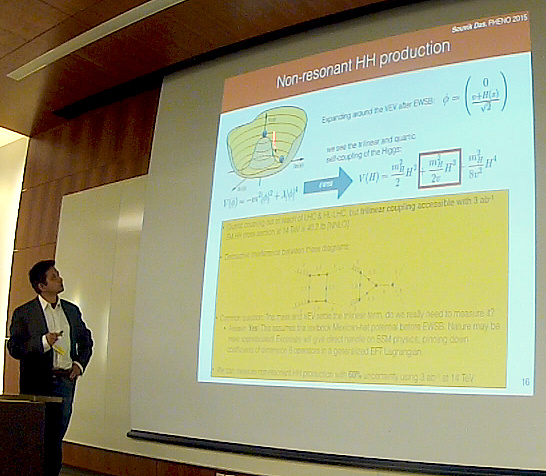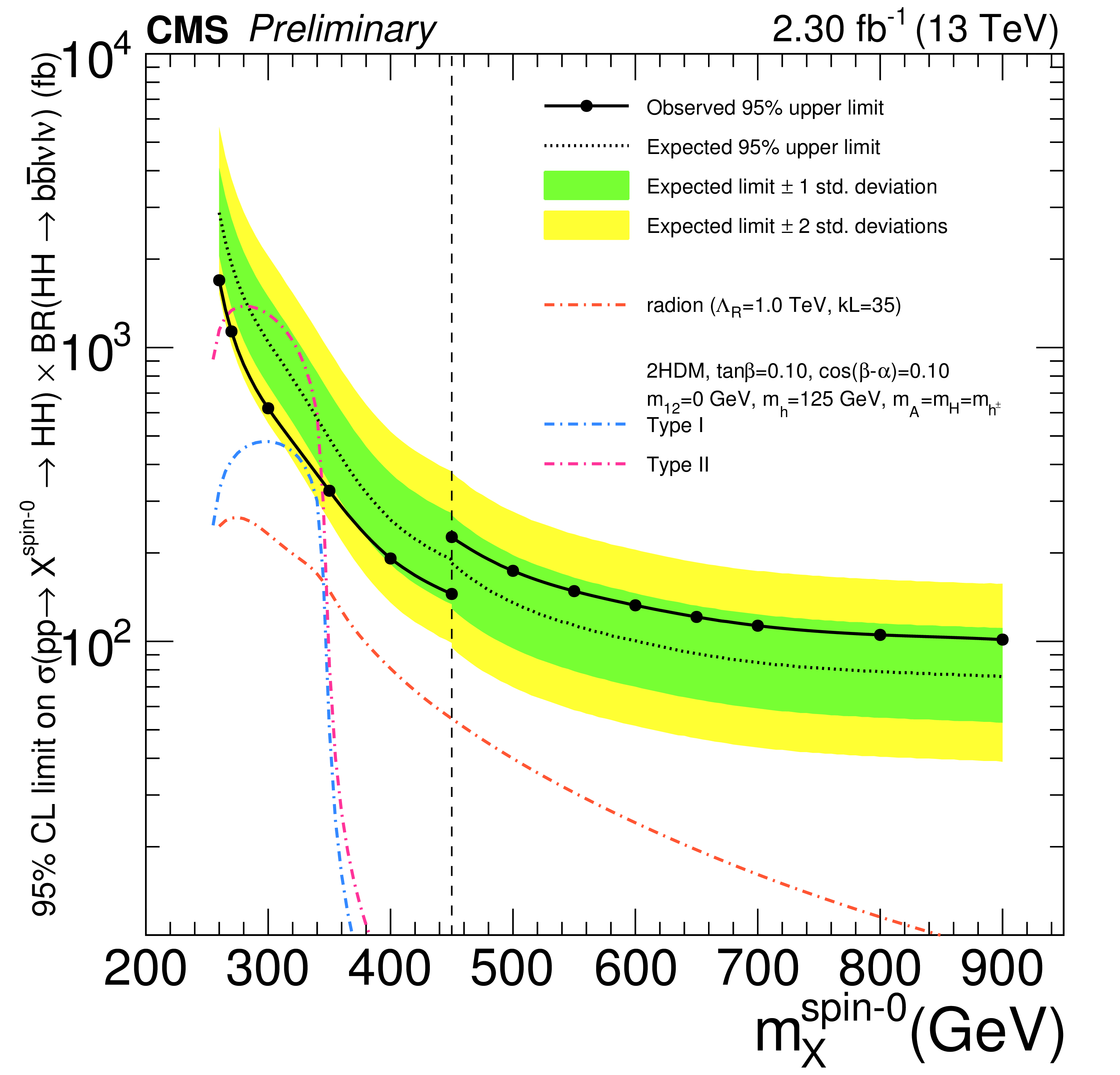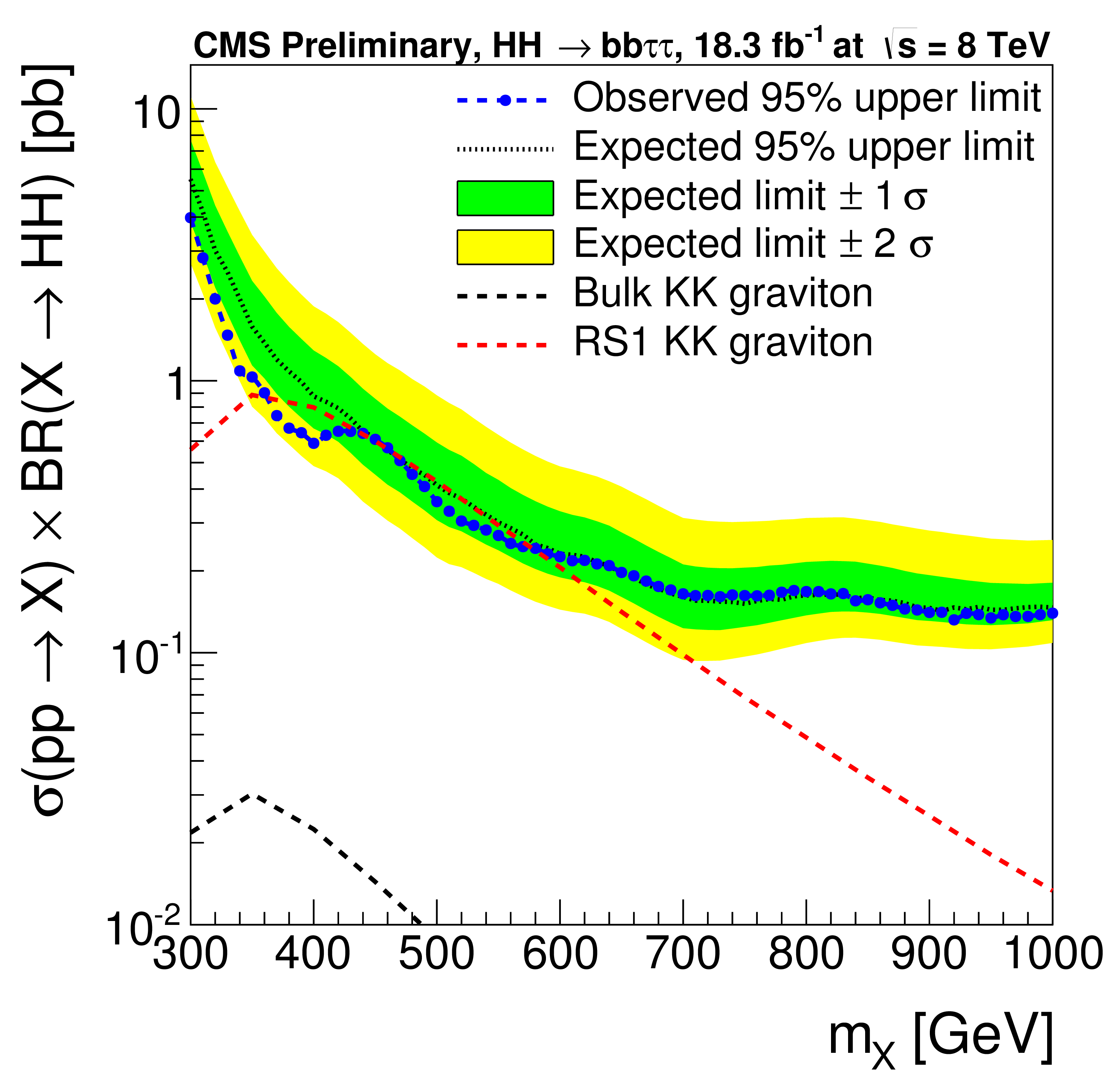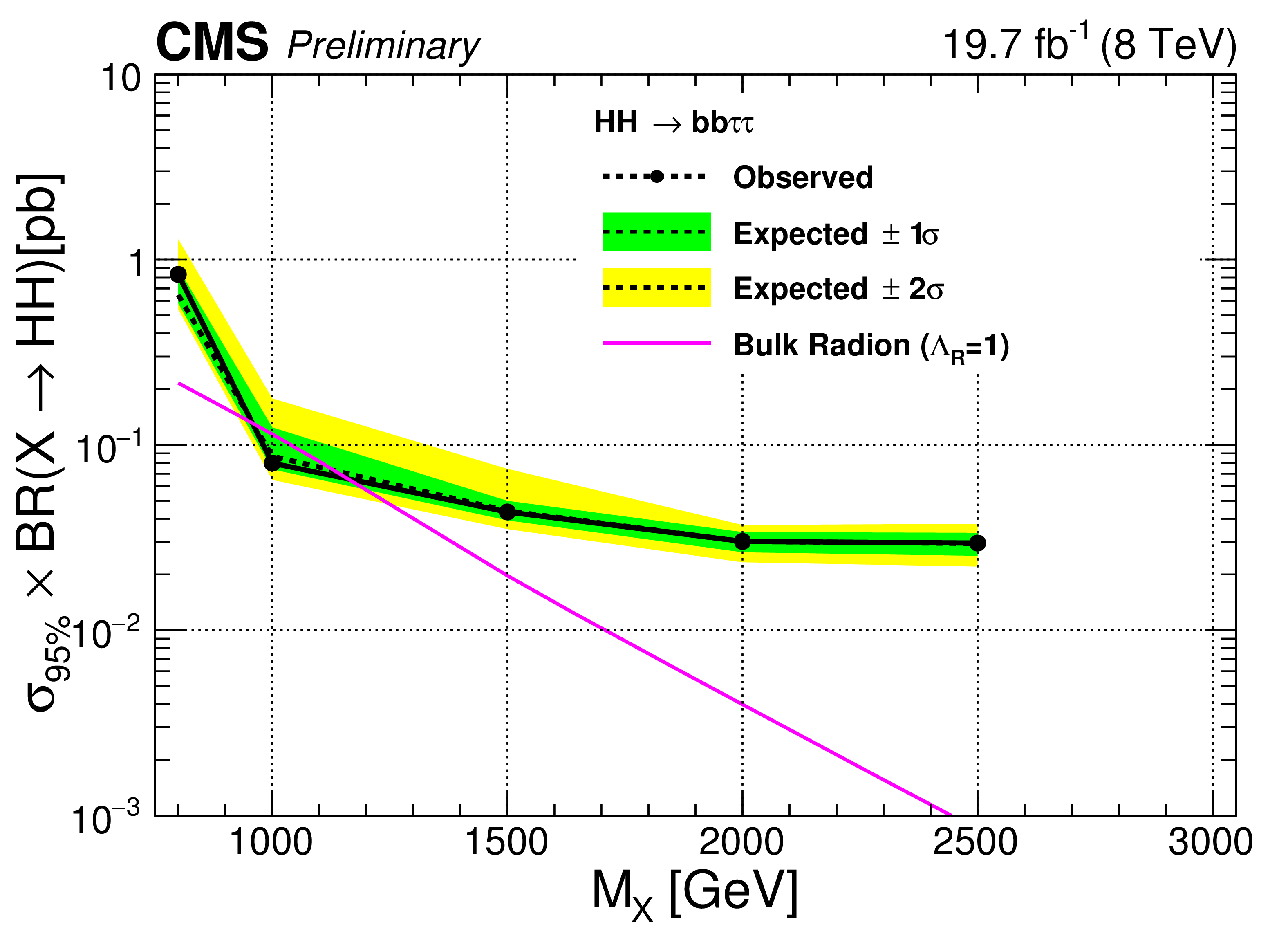
HH at PHENO 2015
After the discovery of the Higgs boson, it has become experimentally and theoretically important to see if it is produced in pairs at the LHC. I have taken a leading role within the CMS experiment to search for such pair production.
| The Standard Model of Particle Physics allows for non-resonant pair production of the Higgs boson, but the theoretical production cross section is approximately 10 fb and too small to be detected with currently acquired data. However, several well-motivated hypotheses of physics beyond the Standard Model posit resonances that decay into pairs of Higgs bosons and can be probed with existing data. One class of hypotheses that give rise to particles that can decay to HH are the Randall--Sundrum (RS1) models of warped extra dimensions. In these models, a 5th "bulk" dimension of finite radius is posited which when traversed results in an exponential shrinkage of the spacetime metric. The radius of the bulk dimension must be stabilized against quantum fluctuations, and this is done by the Goldberger-Wise mechanism with a spin 0 field called the radion. This radion, if heavier than 250 GeV, can decay into HH. Additionally, fundamental frequencies of the spacetime metric within the bulk, or Kaluza-Klein modes of the graviton, result in spin 2 particles that can also decay into HH if heavier than 250 GeV. |
 HH at PHENO 2015 |
Below I list the various searches for Higgs pair production at CMS that are currently public. Click on the legend to go to the corresponding analysis.



Main analysts: Souvik Das, Caterina Vernieri, Jacobo Konigsberg, Andrea Rizzi
A model-independent search for a narrow resonance produced in proton-proton collisions at 8 TeV and decaying to a pair of 125 GeV Higgs bosons that in turn each decays into bottom quark-antiquark pairs is performed by the CMS experiment at the LHC. The analyzed data correspond to an integrated luminosity of 17.9 /fb. No evidence for a signal is observed. Upper limits at a 95% confidence level on the production cross section for such a resonance, in the mass range from 270 to 1100 GeV, are reported. Using these results, a radion with decay constant of 1 TeV and mass from 300 to 1100 GeV, and a Kaluza-Klein graviton with mass from 380 to 830 GeV are excluded at a 95% confidence level.
Paper: Phys. Lett. B 749 (2015) 560
In the media: Fermilab News
e-print: arXiv:1503.04114 [hep-ex]
inSPIRE record: http://inspirehep.net/record/1352128
Public Twiki: http://cms-results.web.cern.ch/cms-results/public-results/publications/HIG-14-013/index.html


Main analysts: Souvik Das, Caterina Vernieri, Silvio Donato, Jacobo Konigsberg, Andrea Rizzi
A model-independent search for a narrow-width resonance decaying into two Higgs bosons, each having a mass of 125 GeV and decaying into a (bb) pair, is presented. The search is performed using proton-proton collision data corresponding to an integrated luminosity of 2.3 /fb at 13 TeV recorded by the CMS detector at the LHC. No evidence for a signal is observed and upper limits at a 95% confidence level on the production cross section for such a resonance, in the mass range from 260 to 1200 GeV, are set.
Physics Analysis Summary paper: HIG-16-002
Public Twiki: http://cms-results.web.cern.ch/cms-results/public-results/preliminary-results/HIG-16-002/index.html

A search is presented for narrow heavy resonances X decaying into pairs of Higgs bosons (H) in proton-proton collisions collected by the CMS experiment at the LHC at sqrt(s)=8 TeV. The data correspond to an integrated luminosity of 19.7 inverse femtobarns. The search considers HH resonances with masses between 1 and 3 TeV, having final states of two b quark pairs. Each Higgs boson is produced with large momentum, and the hadronization products of the pair of b quarks can usually be reconstructed as single large jets. The background from multijet and t-tbar events is significantly reduced by applying requirements related to the flavor of the jet, its mass, and its substructure. The signal would be identified as a peak on top of the dijet invariant mass spectrum of the remaining background events. No evidence is observed for such a signal. Upper limits obtained at 95% confidence level for the product of the production cross section and branching fraction sigma(gg to X) B(X to HH to b-bbar b-bbar) range from 10 to 1.5 fb for the mass of X from 1.15 to 2.0 TeV, significantly extending previous searches. For a warped extra dimension theory with a mass scale Lambda[R] = 1 TeV, the data exclude radion scalar masses between 1.15 and 1.55 TeV.
e-print: arXiv:1602.08762 [hep-ex]
inSPIRE record: https://inspirehep.net/record/1424833
Public Twiki: https://cms-results.web.cern.ch/cms-results/public-results/preliminary-results/EXO-12-053/index.html


Main analysts: Maxime Gouzevitch, Alexandra et al.
A search is presented for the production of two Higgs bosons in final states containing two photons and two bottom quarks. Both resonant and nonresonant hypotheses are investigated. The analyzed data correspond to an integrated luminosity of 19.7 /fb of proton-proton collisions at 8 TeV collected with the CMS detector. Good agreement is observed between data and predictions of the standard model (SM). Upper limits are set at 95% confidence level on the production cross section of new particles and compared to the prediction for the existence of a warped extra dimension. When the decay to two Higgs bosons is kinematically allowed, assuming a mass scale Lambda_R = 1 TeV for the model, the data exclude a radion scalar at masses below 980 GeV. The first Kaluza-Klein excitation mode of the graviton in Randall-Sundrum models is excluded for masses between 325 and 450 GeV. Limits set on nonresonant production constrain the parameter space for anomalous Higgs boson couplings.
Paper: Submitted to Phys. Rev. D
e-print: arXiv:1603.06896 [hep-ex]
Public Twiki: http://cms-results.web.cern.ch/cms-results/public-results/publications/HIG-13-032/index.html


A search for resonant Higgs bosons pair production decaying into bbWW with subsequent WW decays into two leptons and two neutrinos, X --> HH --> bbWW --> bb(l nu)(l nu), is presented. The analysis is based on a sample of proton-proton collisions at 13 TeV at the LHC corresponding to an integrated luminosity of 2.3 /fb. Masses are considered in the range between mX = 260 GeV and 900 GeV. The search focuses on the invariant mass distribution of the b-jet pair, searching for a resonant-like excess compatible with the H boson mass in combination with a boosted decision tree discriminant based on kinematic information. Data and predictions from the standard model are in agreement within systematic uncertainties. For mass hypotheses from mX = 500 GeV to mX = 900 GeV, the data are observed (expected) to exclude a production cross-section times branching ratio of a spin-0 particle from 174 to 101 (135 to 75.8) fb.
Physics Analysis Summary paper: HIG-16-011
Public Twiki: http://cms-results.web.cern.ch/cms-results/public-results/preliminary-results/HIG-16-011/index.html

A search for a heavy scalar boson H decaying into a pair of lighter standard-model-like 125 GeV Higgs bosons h and a search for a heavy pseudoscalar boson A decaying into a Z and an h boson are presented. The searches are performed on a dataset corresponding to an integrated luminosity of 19.7 /fb of pp collision data at a centre-of-mass energy of 8 TeV, collected by CMS in 2012. A final state consisting of two tau leptons and two b jets is used to search for the H --> hh decay. A final state consisting of two tau leptons from the h boson decay, and two additional leptons from the Z boson decay, is used to search for the decay A --> Zh. The results are interpreted in the context of both the minimal supersymmetric extension of the standard model and two-Higgs-doublet models. No excess is found above the standard model expectation and upper limits are set on the heavy boson production cross sections in the mass ranges 260 < mH < 350 GeV and 220 < mA < 350 GeV.
Paper: Phys. Lett. B 755 (2016) 217
e-print: arXiv:1510.01181 [hep-ex]
Public Twiki: https://cms-results.web.cern.ch/cms-results/public-results/publications/HIG-14-034/index.html


Results of a search for the production of Higgs boson pairs are presented. In this search one Higgs boson decays to a pair of b-quarks, and the other Higgs boson decays to a tau lepton pair where the tau leptons decay hadronically. The search is based on proton-proton collision data recorded by the CMS experiment at 8 TeV in 2012, corresponding to an integrated luminosity of 18.3 /fb. The resonant and the non-resonant productions of Higgs boson pairs are studied. No significant excess with respect to the background-only hypothesis is observed in the data and therefore corresponding upper limits on cross section times branching ratio are set. In the case of resonant HH boson production, the limit on xsec(pp-->X) x BR(X-->HH) for a resonance of spin 0 (spin 2) and mass mX, ranges from 5.42 pb (3.97 pb) at mX = 300 GeV to 0.14 pb (0.14 pb) at mX = 1000 GeV. The limit on non-resonant production amounts to approximately 50 times the rate predicted by the SM.
Physics Analysis Summary paper: HIG-15-013
Public Twiki: https://cms-results.web.cern.ch/cms-results/public-results/preliminary-results/HIG-15-013/index.html

A search for a massive resonance decaying into a pair of Higgs bosons, one of which decays to a pair of tau leptons and the other to a pair of bottom quarks, is presented. This analysis is based on the proton-proton collisions data sample collected at a centre-of-mass energy of 8 TeV at CMS in 2012, corresponding to an integrated luminosity of 19.7 /fb. For a high-mass (larger than 1 TeV) resonance, the hadronization products of the bottom quarks coming from one of the two intermediate H bosons give rise to the presence of one single ``merged'' jet, which can be identified through a study of its substructure consistent with the presence of bottom quarks. Due to the large boost of the intermediate H boson, the two tau leptons are similarly overlapping. Advanced techniques are used for their reconstruction and identification in events where one tau decays hadronically and the other one decays into an electron or a muon. Upper limits at 95% confidence level are set on the cross section of a spin-0 resonance ranging from 850 to 30 fb for resonance masses between 800 and 2500 GeV.
Physics Analysis Summary paper: EXO-15-008
Public Twiki: http://cms-results.web.cern.ch/cms-results/public-results/preliminary-results/EXO-15-008/